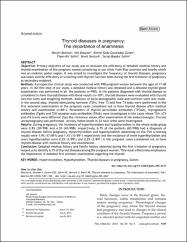Thyroid diseases in pregnancy: the importance of anamnesis

Göster/
Erişim
info:eu-repo/semantics/openAccessTarih
2013Yazar
Bulmuş, NecatiÜstüner, Işık
Güven, Emine Seda Güvendağ
Şahin, Figen Kır
Şentürk, Şenol
Şahin, Serap Baydur
Üst veri
Tüm öğe kaydını gösterKünye
Bulmus, N., Ustuner, I., Guven, E.S.G., Sahin, F.K., Senturk, S., Sahin, S.B. (2013). Thyroid diseases in pregnancy: The importance of anamnesis. Pakistan Journal of Medical Sciences, 29(5), 1187.1192. https://citeseerx.ist.psu.edu/viewdoc/download?doi=10.1.1.770.188&rep=rep1&type=pdfÖzet
Objective: Primary objective of our study was to evaluate the efficiency of detailed medical history and thyroid examination of the pregnant women presenting to our clinic from Rize province and nearby which was an endemic goiter region. It was aimed to investigate the frequency of thyroid diseases, pregnancy outcomes and the efficiency of screening with thyroid function tests during the first trimester of pregnancy as secondary endpoint. Methods: A prospective clinical study was conducted with 998 pregnant women between the ages of 17-48 years. in the first step of our study, a detailed medical history was obtained and a detailed thyroid gland examination was performed in all the patients (n=998). in the patients diagnosed with thyroid disease or considered to have thyroid disease with these results (n=107), thyroid diseases were evaluated with thyroid function tests and imagining methods. Analyses of socio-demographic data and nutrition were also made. in the second step, thyroid stimulating hormone (TSH), free T3 and free T4 tests were performed in the first antenatal examination of the pregnant cases considered not to have thyroid disease after medical history and examination (n=891). Parameters of thyroid peroxidase antibodies (TPOAb), thyroglobulin antibodies (TgAb) and TSH receptor auto antibodies (TRAb) were investigated in the cases whose TSH, sT3 and sT4 levels were different than the reference values after examination of the endocrinologist. Thyroid ultrasonography was performed. Urinary iodine levels in 24 hour urine were investigated. Results: During pregnancy, the incidence of hyperthyroidism and hypothyroidism in the whole study group were 2.8% (28/998) and 4.3% (43/998), respectively, 6.7% of the patients (67/998) had a diagnosis of thyroid disease before pregnancy. Hyperthyroidism and hypothyroidism depending on the TSH screening results were 1.9% (17/891) and 1.1% (10/891) respectively and the incidence of overt hyperthyroidism and overt hypothyroidism were 0.2% (2/891) and 0.2% (2/891) in the pregnant cases considered not to have thyroid disease with medical history and examination. Conclusion: Detailed medical history and family history obtained during the first trimester of pregnancy helped us to identify 6.7% of thyroid diseases among the pregnant women. This result effectively emphasizes the importance of detailed first prenatal examination regarding the thyroid.
Kaynak
Pakistan Journal of Medical SciencesCilt
29Sayı
5Bağlantı
https://hdl.handle.net/11436/3281https://citeseerx.ist.psu.edu/viewdoc/download?doi=10.1.1.770.188&rep=rep1&type=pdf

















